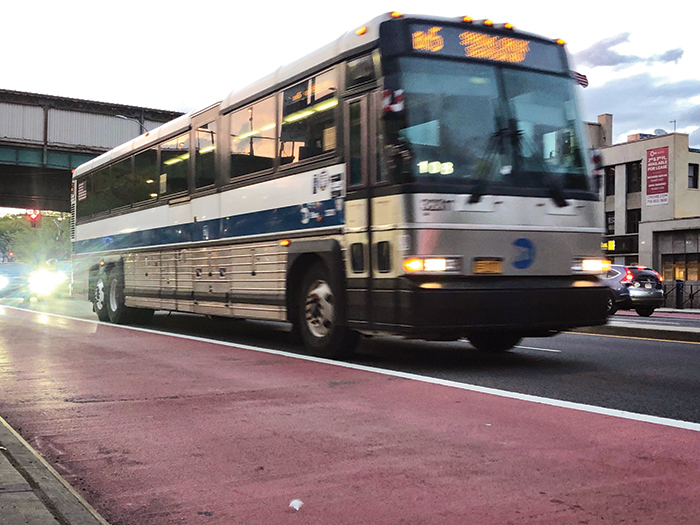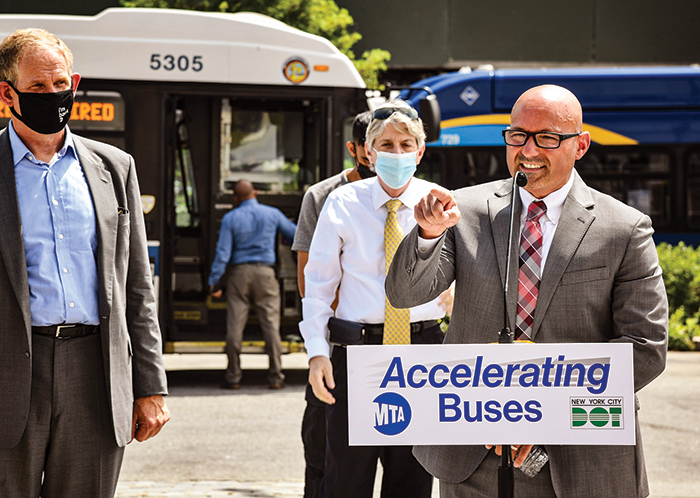Forum Photo by Michael V. Cusenza
“This new plan utilizes everything in our toolbox to speed up travel times, giving New Yorkers a clear incentive to choose the bus as their mode of choice,” NYC Transit Interim President Cipriano said.
By Michael V. Cusenza
The Metropolitan Transportation Authority and the City Department of Transportation on Monday announced an ambitious plan to improve NYC’s expansive—and largely painfully slow—bus network.
New and Improved Bus Lanes and Busways
MTA and DOT officials indicated that they agree that bus lanes and busways are among the most effective tools for increasing bus speeds. Starting in 2022, DOT will embark on major projects to add or improve 20 miles of bus lanes, including up to five new busway pilots. These projects, developed over the next several months in coordination with the MTA, will be designed to serve bus riders in critical areas of the city.
Dedicated bus lanes and busways have yielded what the MTA has characterized as “outstanding” results throughout the city in recent years. On the 14th Street busway, travel times have improved by 36 percent in the last year from pre-busway travel times. The improved speeds helped fuel pre-pandemic increases in ridership as well, with ridership up 24 percent on M14 SBS service. In the Bronx, the Bx6 SBS route began operating along dedicated bus lanes in 2017, and travel times improved by 11 to 16 percent.
In April, the MTA worked with NYCDOT to launch the 181st StreetBusway Pilot in Washington Heights, which has increased bus speeds by up to 34 percent, improving commute times for riders on five Bronx routes traveling to and from Manhattan. This unprecedented improvement followed the installation of a busway pilot on Main Street in Flushing, Queens in January 2021. Average bus speeds along the Main St busway were up to 25 percent faster during peak periods between October 2020 and May 2021.
In July 2020, offset bus lanes were installed on 149th Street in the Bronx for riders on the Bx2, Bx4, Bx17, and Bx19. This installation work has been successful in speeding up trip times in population-rich parts of the borough. Average bus speeds along 149th Street were up to 14 percent faster during peak periods between October 2019 and May 2021.
Contributing to improved performance is DOT’s installation of 16.3 new miles for bus lanes and busways in 2020.
These bus lanes and busways are on bus routes that, pre-pandemic, served over 340,000 daily bus riders. The projects included:
- Queens – Merrick Blvd Bus Lane, 5.9 miles
- Brooklyn – Malcolm X Blvd, 0.1 miles; Jay St busway pilot, 0.8 miles
- Bronx – 149 St Bus Lane, 2.7 miles; University Ave, 0.1 mi; El Grant Highway Bus Lane, 1.2 miles
- Manhattan – 14 St Bus Lane, 0.8 miles
- Staten Island – Hylan Blvd Bus Lane, 4.7 miles
Expanded Bus Lane Camera Enforcement
One key to speeding bus service is more frequent and more consistent enforcement of busway and bus lane rules – especially for delivery vehicles and other chronic violators. Bus lane camera enforcement technology currently exists in all five boroughs, and MTA and DOT have agreed to expand camera enforcement to cover up to 85 percent of existing bus lanes by the end of 2023.
To reach that goal, the MTA has committed to more than tripling the number of cameras onboard buses in 2022, adding 300 cameras, with the plan to add at least 600 more in 2023. Approximately 30 percent of bus lane miles are covered with onboard bus cameras. DOT will complement this effort by adding fixed cameras on up to 15 new corridors in 2022. The fixed cameras will work in concert with the bus cameras to reduce the number of illegal cars and other vehicles in bus lanes.
Transit Signal Priority Expansion

Forum Photo by Michael V. Cusenza
MTA and DOT officials said they will build off ongoing efforts that have already yielded faster bus speeds, and implement new initiatives to enhance the customer experience to ensure that the MTA bus system is ready to support New York City’s recovery.
The MTA and DOT will expand Transit Signal Priority to up to 750 additional intersections throughout the city in 2022.TSP helps buses spend less time at red lights by allowing buses approaching an intersection to get a shortened red light or an extended green light in real-time.
The MTA partnered with DOT to install this effective technology at more than 1,700 intersections throughout the city since 2012, and the pace of installation has grown substantially despite the pandemic. In partnership with the MTA, DOT added 648 intersections with TSP in 2020. The expansion was by far the largest addition of TSP in any year since the first activation in 2012. New activations occurred in all five boroughs including more than 120 intersections along the B82 SBS route in southern Brooklyn. This year, more than 300 intersections have already been brought online.
Bus Network Redesign
Bus network redesigns are among the biggest improvements the MTA can do to ensure New Yorkers receive appropriate bus service, which is why the MTA will restart its Bus Network Redesign program this fall, beginning with the resumption of the Bronx local bus redesign that will be implemented next summer.
The MTA will monitor emerging ridership patterns and incorporate these patterns in its upcoming redesign to better match bus service with current and future travel demands. Public outreach is expected to begin as early this fall. The MTA will coordinate redesign plans with DOT to ensure that the redesigned networks have the needed bus priority.
OMNY All-Door Boarding Pilot Coming to 10 Local Bus Routes
One of the most anticipated features among bus riders is the implementation of all-door boarding using the Authority’s contactless fare payment system, OMNY.
In December 2020 the MTA announced that approximately 15,000 OMNY readers have been installed on the MTA’s 5,800 bus fleet. On pilot routes, customers using OMNY will be able to enter through any door in an effort to speed up boarding times. Exact routes are still in the process of being selected. The pilot will help give the Authority a better understanding of the impact all-door boarding can have on travel time, boarding times and OMNY usage. The expectation is to implement all-door boarding on all buses by the time the MetroCard is retired by the end of 2023.
Commitment to Accessibility
Improving accessibility to the bus network is a top priority for the MTA and NYCDOT. The entire MTA bus fleet has been made ADA accessible, but other barriers remain. NYCDOT will pursue new projects focused on improving the physical accessibility of bus stops across the city, and has targeted accessibility improvements for 25 bus stops in 2022.
Throughout 2021 and 2022, the MTA expects to put more than 800 new buses, approximately 17% of its local fleet, into service with more flexible seating options in the priority and courtesy seating area designed to accommodate diverse customer needs. The buses will feature three new, single seats indicated by decals that will be able to flip up to accommodate customers with walkers, folded strollers, and other belongings. Two are single aisle-facing seats on the bus operator’s side and one is a forward-facing seat on the curb side. The new buses will also feature wider doors and ramps designed to make it easier to enter and exit the bus.
Improved Bus Schedules and Real-Time Information
All the initiatives laid out by the MTA and DOT look to vastly improve the customer experience. To take advantage of all the existing and upcoming improvements, the MTA will improve bus schedules on at least 15 routes in an effort to reduce travel times.
In addition to improving schedules, the MTA and NYCDOT will upgrade real-time information for bus riders. The MTA is adding over 1,000 onboard digital information screens by the end of 2022, bringing the total number of buses equipped with these screens to approximately 64% of the fleet. NYCDOT are in the process of developing a new prototype bus time pole that will provide bus riders with real-time information signs at bus stops.
“I want to congratulate Acting Chair Janno Lieber and his MTA team for developing a real collaboration with New York City DOT,” said State Sen. Leroy Comrie (D-St. Albans), chairman, Senate Committee on Corporations, Authorities and Commissions. “The need to infuse new technology to improve bus ridership throughout the city has already proven effective, but we must also work diligently to ensure that we increase community and business participation in these discussions to ensure those impacted understand the benefits and the possibilities new technology bring to improve ridership for our essential consumers—bus riders.”
NYC Transit Interim President Craig Cipriano added, “This new plan utilizes everything in our toolbox to speed up travel times, giving New Yorkers a clear incentive to choose the bus as their mode of choice.”

